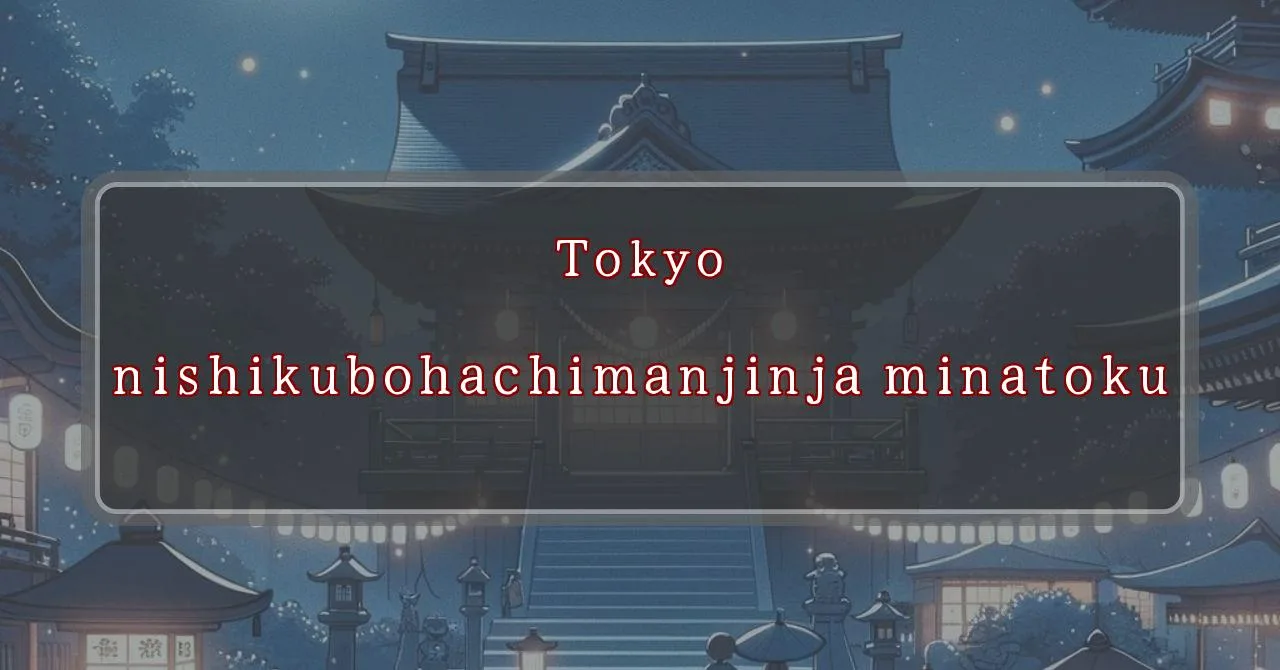Glowing lanterns illuminate the night at Nishikub八幡 Shrine
Basic Information
Nishikubo Hachiman Shrine is a Shinto shrine located in the Toranomon district of Minato, Tokyo, Japan.
- Address: 5-10-14 Toranomon, Minato-ku, Tokyo 105-0001
- Phone Number: 03-3436-2765
- Access: 5-minute walk from Kamiyacho Station on the Hibiya Subway Line, or 1-minute walk from Toranomon-gochome bus stop
- Festival Days: August 13th, 14th, and 15th, 2024
Main Events and Attractions of the Festival
The Nishikubo Hachiman Shrine Festival is a lively and colorful event that attracts many visitors each year. The main events and attractions of the festival include:
Mikoshi Procession
The highlight of the festival is the mikoshi procession, which takes place on the second day of the festival. A mikoshi is a portable shrine that is carried through the streets by a team of people. The mikoshi of Nishikubo Hachiman Shrine is particularly large and impressive, and it is carried by a team of over 100 people. The procession is accompanied by music and dancing, and it is a great opportunity to experience the vibrant atmosphere of the festival.
Kagura Performance
Kagura is a traditional Japanese dance that is often performed at Shinto shrines. During the Nishikubo Hachiman Shrine Festival, kagura performances are held on both days of the festival. The dances are performed by young women dressed in colorful costumes, and they tell stories from Japanese mythology. Kagura is a beautiful and graceful dance, and it is a great way to learn more about Japanese culture.
Food Stalls
No Japanese festival is complete without food stalls, and the Nishikubo Hachiman Shrine Festival is no exception. There are many food stalls set up around the shrine, selling a variety of delicious Japanese dishes. Some of the most popular dishes include yakitori (grilled chicken skewers), takoyaki (octopus balls), and taiyaki (fish-shaped cakes filled with sweet red bean paste). There are also many stalls selling souvenirs, such as t-shirts, hats, and keychains.
Fireworks Display
The festival concludes with a spectacular fireworks display on the evening of the second day. The fireworks are launched from a barge in the nearby Tokyo Bay, and they light up the night sky with their brilliant colors. The fireworks display is a beautiful and fitting end to the Nishikubo Hachiman Shrine Festival.
Blessings and Deities
Nishikubo Hachiman Shrine is dedicated to the following three deities:
-
Yorinobu, a samurai warrior who was the great-grandfather of Minamoto Yoritomo, the founder of the Kamakura shogunate. Yorinobu is said to have enshrined the deity Homuda-wake-no-mikoto at the site of the current shrine after receiving an oracle from the god. The shrine was originally located in Kasumigaseki, but it was moved to its present location in 1590 by Tokugawa Ieyasu, the founder of the Tokugawa shogunate.
- The shrine is open every day from 9:00 AM to 5:00 PM.
- Admission is free.
- There is a small museum on the shrine grounds that displays artifacts related to the shrine’s history.
- The shrine is a popular spot for weddings and other ceremonies.
- There are several restaurants and shops in the area around the shrine.
Nishikubo Hachiman Shrine has a long and storied history. It was a popular shrine among the samurai class during the medieval period, and it was also visited by many common people who prayed for good luck and protection. The shrine was destroyed by fire several times over the centuries, but it was always rebuilt. The current shrine buildings date from the early 20th century.
Tips and Notes for Visitors
Here are some tips and notes for visitors to Nishikubo Hachiman Shrine:
Parking Information
There is no parking lot at Nishikubo Hachiman Shrine. However, there are several coin-operated parking lots in the area. The closest parking lot is located about a 5-minute walk from the shrine.
Popular Stalls and Food Carts in Recent Years
| Type of Stall | Description |
|---|---|
| Takoyaki | A staple at Japanese festivals. Characterized by a crispy outside and a creamy inside. |
| Jaga Butter | A simple yet popular snack of hot potatoes lavishly topped with melted butter. |
| Baby Castella | Small castella cakes, sweet and fluffy treats enjoyed by children and adults alike. |
| Grilled Ayu with Salt | Fresh ayu fish grilled whole with salt, a savory taste of Japanese summer. |
| Shaapin | A unique gourmet item influenced by foreign cuisine, with a chewy skin wrapping the filling. |
| Okonomiyaki | A Japanese grilled dish where you often choose your own ingredients for a personalized flavor. |
| Cotton Candy | A fluffy, sweet snack that’s extremely popular with children. |
| Chocolate Banana | A banana coated in chocolate, a fun and visually appealing dessert. |
| Kushiyaki | Various types of ingredients skewered and grilled, an easy-to-enjoy snack. |
| Yakisoba | Fried noodles mixed with a special sauce, a fast food favorite in Japan. |



